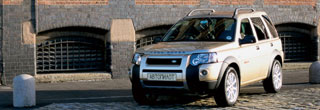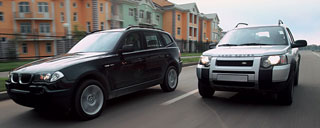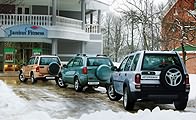Test drive Land Rover Freelander 2003 - 2007 SUV
Active vacationers
Nissan X-Trail and Land Rover Freelander: Please do not stand on the beach in the beachAt the end of the last century, attacking the SUV gold core (the English abbreviation deciphens as cars for outdoor activities), carriers around the world continue to develop it diligently. Models, outwardly resembling SUVs, confidently conquer the market. In fact, why does a citizen be a car for real off -road? The inhabitant of the stone jungle is quite enough with an aggressive appearance, a slightly higher landing and a lightweight all -wheel drive transmission to feel more confident on a relatively bad road. Today, today's heroes of our heading meet all these requirements fully.
Both cars appeared not yesterday, but the Land Rover Freelander, which debuted in 1997, by the current standards of the world auto industry, a real veteran, and last year’s modernization of the model was simply necessary. His opponent is four years younger, but since Japanese cars are updated more often, the Nissan X-Trail also managed to take restyling, slightly refreshing his appearance and interior. In addition, a 2004 model year received an updated 2.2-liter turbodiesel, the capacity of which increased to 136 hp. (however, Russian clients mainly prefer gasoline versions of the X-Trail with 2 l and 2.5 liter engines, developing 140 hp and 165 hp). There are three engines in the range of power units Freelander: two gasoline 1.8 liters and 2.5 liters (117 hp and 177 hp, respectively) and a 2-liter 112-horsepower turbodiesel.
Clients can choose a machine equipped with a mechanical or automatic transmission, but with certain reservations. For example, diesel Nissan is offered only with mechanics, and gasoline Land Rover, on the contrary, only with a machine gun. Accordingly, having decided to test the most powerful versions, we could count exclusively on cars with automatic transmission. In the case of X-Trail, it turned out to be a 4-band E-Flow automatic transmission, Freelander was equipped with a 5-speed Commandshift transmission with the possibility of choosing a manually.
If we talk about external changes, then the fruits of restyling are more noticeable in the exterior of the English SUV. The car received new headlights stylistically close to the senior models of Land Rover. The changes affected the front bumper, now endowed with an integrated kangarine and partially painted in the color of the body, in the rear bumper additional lanterns in general Freelander became even more brutal, and comparison with the hippo (remember, was there such an advertising video?) The renewed car no longer withstands. Therefore, (apparently, in the absence of fresh non -zoological ideas), the image of an armadillo was used in the Freelander 2004 promotion campaign to promote 2004.
Changes in the appearance of X-Trail to notice much more difficult here are everything at the level of the nuances. The list of updated parts contains the front and rear bumpers (they have become more compact, which improved geometric cross -country ability and simplified parking in constrained conditions), a radiator grille, rear lights, and fog lights. Additional headlight headlights integrated into luggage roof rails, previously available only in the SV configuration, are now offered in Sport and Elegance performances. Of course, this like a jupering chandelier, of course, decorates, however, it will not be often necessary to use the fashion accessory by the SUV owners: to blind the surrounding highlight on public roads, agree, it is not worthless, and the off-road does not categorically recommend the instruction manual.
However, we will return to the running capabilities of our heroes a little later, but for now we will evaluate their updated salons. Compared to the predecessor, the interior of Frelander has changed significantly. First of all, this is noticeable in the combination of devices, where secondary signs are located not at the edges of the tachometer and speedometer, but between them. However, the rearrangement did not add information content: digitization of the scales is still slurred, and reading the devices is still inconvenient. The controversial from the point of view of ergonomics also looks like the transfer of the rear wiper control buttons from the tank of the dashboard to the center of the torpedo.
If earlier they were hiding from the driver behind the rim of the steering wheel, now they have to reach for them. The list of innovations continues a couple of cup holders who took the place of the shelves on the front panel. The electric windows control unit moved from the central tunnel to a more traditional place for the armored door of the driver's door. By the way, the buttons of electric windows cause a persistent sensation of deja-vu. As it turned out, not in vain: exactly the same block is installed on the Ford Maverick. The associative series is continued by the audio system, already visible by the author of these lines in the Ford Fiesta salon, unification, you understand
The X-Trail salon also could not do without changes. The shape of the front panel, as well as the climate system deflectors integrated into it, was somewhat modified. Small shelves at the front racks have acquired lids, and the white scales of the devices are located, as before, in the center of the torpedo steel became black. According to the manufacturer, it has become easier to manage the climate control system. In our opinion, no fundamental changes have occurred: the system clearly does not differ information and intuitive understandability.
It is enough to say that it is extremely difficult to set the desired temperature with the help of a stray regulator (that the numbers 18, 25 and 32 mean precisely the degrees of Celsius, the driver must still guess).
In fairness, we note that the weather was not lucky with the owners of Frelander: we don’t undertake to judge how the full-time air conditioner copes with the summer heat, but the heater fights somehow sluggishly with a cold. Well, the test car turned out to be with the winter package, including heated windshield (and almost throughout the area, and not just in the zone of wipers, like the X-TRIIL) and heating seats
Active vacation (whether it is a suburban output on Weekend or a real journey) is not complete without the approving of the case of equipment. The cargo capabilities of both machines are approximately equal (the X-Trail trunk is lit, however, surpasses Freelander). However, the compact SUV is not a truck or bus, and the desire to take on board more cargo automatically turns out to be reducing the crew. Say, getting a five -year -old picnic is quite real: provisions and a barbecue set are loaded into the trunk without problems. But going on vacation the same company will no longer be possible: the backpacks-sticks, not to mention the oversized sportentar, the place is clearly not enough to fold the rear seats. In the length of the Nissan freight cargo platform, again ahead: passenger places Land Rover in folded form eat more space. In addition, the backs of the X-Trail seats have a rigid washing upholstery, a similar coating of the luggage compartment floor, and Freelander has an impractical carpet in the trunk.
In general, it is better to travel together together. Moreover, the rear places of a high level of comfort do not promise. You feel especially vividly in the Land Rover salon, where tall passengers constantly have to pull their heads into the shoulders (the ceiling presses in the X-Trail, but at least you can push back the back of the seat of adjustment of an impressively width).
But God with them, with passengers, is time to move to the driver's seat. The developers of the updated Freelander definitely worked on the mistakes of the front seats noticeably prettier. Properly provided, with developed lateral support, upholstered (on our machine) with a successful combination of skin and artificial suede Alcantara, they would guarantee comfort to a person of any complexion, if not one annoying but. Freelander still does not have an adjustment of the chair in height. Considering that it is installed high enough, the only exit remains the only exit to the maximum back to throw back the back.
The height of the X-Trail chair can be varyed (and unlike the Spartan Land Rover, where the seats are not provided at all, our Nissan was fully electrified). True, only people will be able to appreciate the useful option, again, only people. But in general, thanks to the wide range of adjustments, it is quite possible to choose the optimal landing. Well, now the most interesting: let's see what rivals are in motion. Giveled the competitor in power, the Japanese SUV demonstrates a more assertive character: with a readily responding to work by the accelerator (the throttle controls electronics), the car literally tears from the place. It does not cause complaints and an automatic machine, which turned out to be surprisingly quick. Another thing is Freelander. A rigid gas pedal forces to make a significant effort, and the gearbox reacts to the orders of the driver with a clear laziness. However, the traces of modernization are also visible here: before restyling, the machine was even more equanimous.
And what about handling? On dry asphalt, cars behave almost equally in light (thanks to independent pendants: in front of the X-Trail, the MacPherson rack, at the back of the shock absorber racks on parallel levers; Freelander has a maceson everywhere) with a correction due to a relatively high center of gravity. However, when accurate riding, both prescribe turns quite clearly, and the high -speed straight line is held perfectly. Problems begin with a deterioration in road conditions. And here is the time to tell in more detail about the features of the transmission of our heroes.
The X-Trail is armed with the advanced All Mode 4x4 with a controlled electronics system for transmitting and distributing torque. The driver selects one of three modes on the dashboard by the switch. In position 2WD (recommended for economical driving along a dry road) only front -wheel drive is involved. In Auto mode, torque, using an electronically controlled multi-disc coupery, is transmitted to the rear wheels when front slipping, for example, at the beginning of movement or with sharp accelerations. Finally, in the position of the Lock, the clutch is blocked and the distribution of the moment along the axes occurs rigidly, in the ratio of 57:43. This mode is used on off -road at speeds of up to 30 km/h and automatically turns off when the speed increases.
Nissan experts say that the ALL Mode 4x4 transmission is favorably different from other all -wheel drive systems (for example, implemented using a viscous coupling) with speed: the permissible slipping of the front wheels until the rear in it is only a few degrees from the full turn of the wheel. The experience of traveling to Frelander, whose rear wheels are given just through Viskioft, forces to divide this opinion. Moments, so far, reacting to slipping the front wheels, the silicone will compact and involve the rear, seem languidly long in an extreme situation. In practice, it looks something like this. Entering a high -speed turn, the front -wheel drive Freelander seeks to endure the front. But as soon as the driver start the correction, how the rear wheels enter into business and the car abruptly goes into the skid.
In general, you should not particularly accelerate the wheel of a small Land Rover. Moreover, unexpectedly heavy (as if there is no amplifier here), the steering wheel does not shine with informativeness, and it is not easy to track the moment when on a slippery coating the car begins to lose contact with the road. It is interesting that the pre -restyling version of Frelander caused similar complaints, but it never occurred to the British to supply the car with a target stability system. But along with these Land Rover SUVs, the baby is equipped with a proprietary HDC system, which provides controlled movement under the slope. Yes, and the ETC anti -wings system is also mainly sharpened for off -road driving, it imitates the blocking of inter -axle differentials. Using the working brake system, the ETC slows the boxing wheels, allowing you to realize a larger torque on wheels with the best clutch.
The ESP+course stability system, which (optionally), is equipped with the X-TRIIL version. The only difference is that electronics affects not only the brake system, but is capable of strangling the engine at the right time. In combination with the capabilities of the electronic transmission, this greatly facilitates the driving of the Japanese SUV: in all-wheel drive mode, the car behaved extremely correctly. True, unlike a competitor shod in all-season rubber, on the wheels of the X-Trail there were tires with spikes.
Given this circumstance and remembering the warning, not to meddle on the off-road contained in the instructions for Nissan, we did not begin to subject the car with any serious off-road tests. They limited themselves to a light march on a shallow snow virgin land. Frankly, not without trepidation: from the gigper attributes on both SUVs, there is only a blocked interdose differential of the Japanese. Yes, and the road gaps of cars are by no means outstanding (Frelander has only 186 mm, and the manufacturer is modestly silent about the size of the clearance of X-Trail) to look for the tractor, fortunately, they did not have to: the subjects coped with the task. By the way, confirming that by positioning the Nissan X-Trail and Land Rover Freelander as real SUVs, their manufacturers, if they are cunning, are not too much.
Text: Andrey Tsybulsky
Source: Mkobil magazine [06.12.2004]









